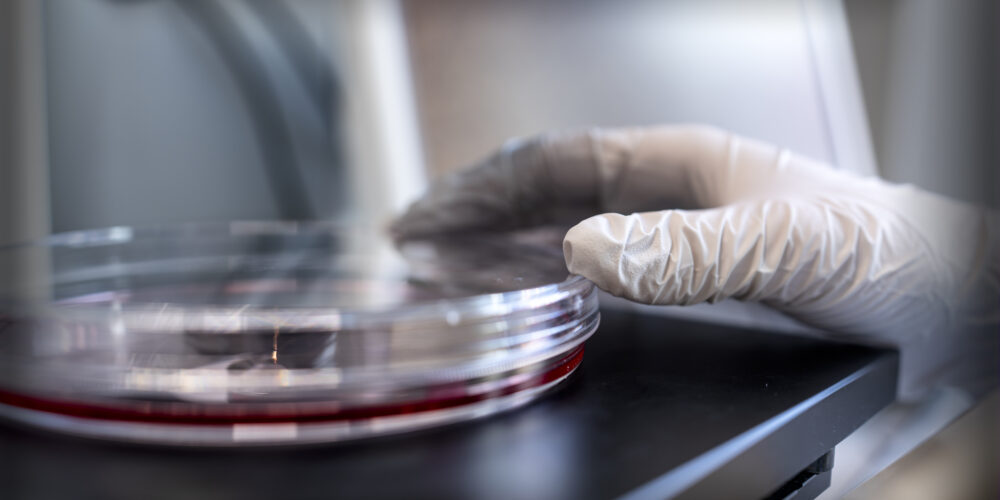As one key element for PanOmics-driven Drug Discovery we have established leading high-throughput and high-resolution transcriptomics data generation capabilities. Transcriptomics, an unbiased approach to quantify mRNAs in a sample, is an excellent method to generate highly multidimensional functional readouts from biological material, thus giving a precise view on the state of cells and organs, while being highly scalable and economical. Using classical bulk (deep) RNA-Seq on thousands of human blood and tissue samples, Evotec has been building a high-quality molecular patient database - E.MPD.
Our flagship asset, the proprietary and massively scalable 384 well based ScreenSeq™ bulk RNA-Seq protocol, has generated more than a million high quality transcriptomes, supported drug screening and profiling campaigns, as well as toxicogenomics by providing reliable highly multidimensional readouts.
High-throughput RNA-Seq is complemented by our high-resolution transcriptomics capabilities that uses state-of-the-art technologies and integrates them into Evotec’s industrialized processes. Evotec is one of the leading players in deploying single cell and single nuclei RNA-Seq. Furthermore, we have built considerable expertise in generating and interpreting spatial transcriptomics for drug discovery. Supporting Evotec’s E.MPD activities, these high-resolution data yield unprecedented details of human disease; for preclinical in vivo studies they allow us to generate an almost “transparent” animal by profiling a range of organs and tissues at high resolution.

Bulk RNA-Seq
Bulk (deep) RNA-Seq is now the classical method for transcriptomics. By deep sequencing, it yields very detailed information about gene expression changes, including the calling of splice variants. This is particularly important for complex samples such as blood or tissue, in which the most relevant cell types are not necessarily abundant. The high sensitivity of deep sequencing is required to analyse lowly expressed genes. Evotec has developed streamlined workflows that allow the processing of thousands of blood or tissue samples from patient cohorts with extensive quality control. This includes robotics solutions for RNA purification as well as automated library preparation. Both steps are tailored to the properties and analytical challenges associated with these sample types, e.g. globin depletion for blood samples and a specific pipeline to generate high quality RNA-Seq data from partially degraded RNA isolated from formalin-fixed paraffin-embedded (FFPE) tissue. The resulting deep RNA-Seq data form the backbone of our E.MPD and enable the data-driven selection of samples of interest that can be analysed in more detail, e.g. using sc/sn-RNA-Seq or spatial transcriptomics.
ScreenSeq
High-throughput transcriptomics is essential for building large molecular databases effectively and is the cornerstone for performing drug discovery screens. Evotec has been pioneering this approach by providing its industry-leading high-throughput transcriptomics platform called “ScreenSeq”. Our laboratories are equipped with state-of-the-art liquid handling robotic systems to handle on 384-well plate basis thousands of samples and multiple projects in parallel. ScreenSeq is suitable for a broad range of input material like 2D/3D cell models, blood, tissues, and RNA samples. Key factors of ScreenSeq are a particularly efficient form of sample barcoding, and labeling with a unique molecular identifier (UMI) for mRNA quantification. An early pooling procedure and an mRNA 3’-end focused library preparation reduce costs compared to classic bulk RNA-Seq significantly. Up to now, more than 1 million transcriptome profiles have been successfully generated via ScreenSeq Such data allow for the identification of relevant drug candidates based on reverting disease signatures back towards a healthy state while allowing a comprehensive evaluation of safety flags and mechanisms of action. This methodology can be used along the entire drug discovery process; one highly valuable use case is Evotec’s E.SAFETY. The massive amount of data that can be generated by ScreenSeq poses a unique challenge with regard to data processing, integration and analyses. To solve this issue, we have developed and optimized our PanHunter bioinformatics platform which provides all necessary functionality.
Sc/snRNA-Seq
Single cell and single nucleus RNA-Seq allow us to analyze the transcriptome of tissues, blood or complex cell mixtures like iPSC-derived differentiated cultures with unprecedented detail. Evotec has been an early adopter of this technology and is now a leading user, processing hundreds of samples every year. Using technologies from 10X Genomics and other providers, we have built industrialized processes that allow the handling of large sample numbers in a consistent and quality-controlled manner. This allows us to develop a deep understanding of disease, bringing our E.MPD to a new level. In the future, this technology will be scaled to even higher throughput to study molecular pharmacology in complex and clinically relevant cellular models, like organoids.
The basis for the industrial scale data generation is decoupling of sample collection and sample processing steps. Here the single nucleus approach has the key advantage due to rather simple and scalable way of sample collection that includes deep freezing of tissue samples. Lower amount of RNA available in nuclei may result in a lower number of detected mRNAs, however still providing sufficient insight into the sample biology.
Beyond classical 3’ RNA-Seq, we have experience with a wide range of additional complementary readouts, including Cite-Seq to analyze cell surface protein markers, or ATAC-Seq to study chromatin structure.
These data generation capabilities are complemented by our PanHunter platform which provides a comprehensive set of tools to process, integrate, analyze and visualize scRNA-Seq and snRNA-Seq data.
Spatial Transcriptomics
Spatial transcriptomics maps transcriptome changes in structurally preserved tissues by combining histological and NGS-based mRNA analysis. Using formalin-fixed paraffin embedded (FFPE) or cryo-preserved tissue sections spatial transcriptomics captures full transcriptome RNA with high resolution in its original location within the tissue. This promotes the analysis of the spatial organization of cell types, cell states as well as biomarker identification. Evotec has been an early adopter of this technology and has created extensive expertise to consistently and reproducibly process cryo- and FFPE preserved tissue samples from mouse and human.
The data generated are processed and analyzed working hand-in-hand between high-resolution imaging analysis, PanHunter multi-omics NGS-analysis and in-depth biological analysis. This includes the identification of macro and microenvironments within a complex tissue structure, pathway enrichment analysis as well as ligand-receptor interaction to support human patient data analysis to understand diseases and their progression from a new angle.
We are convinced that detecting changes in the transcriptome upon disease progression or drug treatment using spatial transcriptomics has the ability to impact all stages of drug discovery and development.

